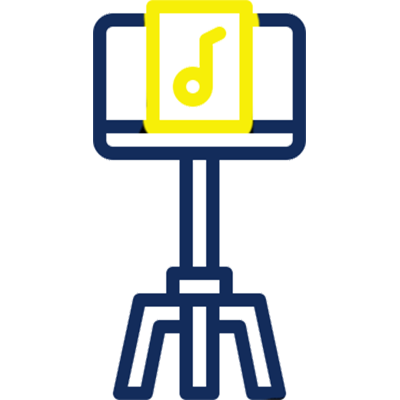Advanced Sound Engineering
Advanced Sound Engineering
Advanced Sound Engineering Course
SBM MUmbai - Advanced Sound Engineering Courses
- DURATION: 1 year
- FEES: INR 220000 ( + TAX)
The music industry is booming in India, with everything from film, regional, classical to electronic dance music and Sound Engineering is one of them. It is the branch of engineering where engineers work on the technicality of sound.
A Sound engineering technician operates, assembles and maintains technical equipment that records, enhances, mixes or reproduces sounds. Sound engineers work in departments like advertising, music, movies, live performances and broadcasting.
Sound Engineering involves learning the skills in studio sound, live sound and sound for mediums like films, TV, videos, etc.
Our Advanced Sound Engineering course is a comprehensive, end-to-end course providing in-depth knowledge to make you a professional and expert sound engineer.
Our proficient faculties and state-of-the-art facilities at our music school enables hands-on experience in sound theory and sound creation.
In the music industry sound plays a very crucial role in sound engineering. Without sound, the cinematic experience is one that feels incomplete and handicapped. Dialogue, music, along with a whole lot of critical auditory components, make a motion picture successful.
The Advanced sound engineering training in mumbai at School of Bollywood Music includes accurate study in core engineering lessons on in-studio mechanics, sound in film and television, and also about the sound acoustics.
Since the film industry itself resides in the heart of Mumbai, there is huge potential for the future of skilled sound engineers with Advanced Sound Engineering classes in India.
School of Bollywood Music has collaborations with various sound studios and established sound artists in Mumbai which gives exposure to our students for live training and expert sessions.
Advanced Sound Engineering course at School of Bollywood Music is a complete package for students looking at a successful career as a versatile sound engineer.
Scope of Sound Engineering
Role of Sound Engineer
A sound engineer designs and manages outputs and sound levels, takes care of handling physical sound equipment like microphones and amps and is responsible for the technical side of a live performance or a recording.
Among others, a sound engineer is responsible for the following activities:
- Sound Design
- Pitch Correction
- Recording
- Editing and Mixing
- Mastering
Career Opportunities in Sound Engineering
If you’re looking to step into the Sound Engineering field, then School of Bollywood Music is here to help you in a variety of fields such as advertising firms, animation, radio stations, movies, multimedia, gaming, and more.
Curriculum
- Vibrations to Sound
- Propagation of Sound
- Speed of Sound
- Waveforms – Sine, Square, Triangle, Sawtooth, Semisine
- Amplitude, Wavelength, Frequency, Calculation of Wavelength from frequency
- Human Hearing & Psychoacoustics
- Concept
- Types – Vu, dBFS, PPM, LUFS, the ‘K’ System
- Phase, Stereo Spread, Spectral Analysis
- Applications
- Types
- Construction & Principle
- Polar Patterns
- Microphone Techniques
- Stereo Microphone Techniques
- Signal Path
- Analogue and Digital Consoles
- Inline and Split Consoles
- Channel Strips
- Input and Output Routing
- Auxes and Busses
- Master Section
- Control Surfaces
- Introduction
- Menus, Options and Preferences
- Input & Output Routing
- ASIO & CORE Audio Optimisation
- Toolbars & Transport
- Tracks – Audio, MIDI, Instrument
- DAW Console
- Signal Routing (internal & external)
- Bus & Aux
- Plugins
- Master Section
- Editing & Fades
- Keyboard Shortcuts
- Session Pool & File Management
- Importing & Exporting Files & Session
- Rendering Options
- Microphone Placement Techniques (Practicals)
- Input Gain (Consoles & Preamps)
- Lead Vocal
- Backing Vocals & Chorus
- String Instruments
- Wind Instruments
- Percussion Instruments
- Drums
- Speaker (Guitars & Bass)
- Studio Session Management
-
- Concept
- Concept of Balance Levels – Dynamic Range – Using Compression and Gain Tonal – EQ Ambience – Reverb Modulation – Delay, Flange, Phasing, Distortion
- Panorama
- History of Music Business
- Functions of a Record Label
- Introduction to Intellectual Property Rights
- Copyrights & Agreements
- Online Music Business
- Management of Content & Aggregators
- Concept
- Sound Design
- Foley effects
- Film and Video Formats
- Sync & Non Sync Effects, Digetic/Non-Diegetic Sounds, Leitmotif
- Track Laying – Practicals
- Foley – Practicals
- Sync, Non-Sync, Diegetic/Non-Diegetic Sounds
- Location Sound
- ADR
- Concept
- dB SPL, dBv, dBu, dBm
- Dynamic Range, Signal to Noise Ratio, Headroom
- Weighted Average (dBa, dBc)
- Boundary Effect
- Inverse Square Law – Demonstration using a Loudspeaker
- Impedance, Standard Operating Levels
- Cables
- Connectors
- Applications
- Soldering Cables & Connectors (Practical)
- Using a Multimeter (Practical)
- Types – Active, Passive
- Drive Units
- Crossovers
- Cabinets
- Wiring & Setups
- Placement Setup & Calibration for Stereo, 5.1, 7.1, Auro 3D & Atmos
- A/D – D/A Conversion
- Sample Rate, Bit Depth, Bitrate
- Quantization, Dither
- Nyquist
- Digital Protocols
- Digital Cables
- Introduction to Acoustics
- Absorption, Diffusion, Reflection
- Isolation
- Room Modes
- RT-60
- Sepermeryer Ratios
- Studio Construction – Walls and Partitions
a) Design Layout
b) Sound Proofing,
c) Acoustic Treatment – Panels
d) Wiring Layout for Audio
e) Wiring Layout for Electricals
f) Electrical Load Distribution and Circuits
g) Door and Windows
h) Air Conditioning
i) Room Calibration - Studio Construction Project (Virtual)
- Dynamics
- EQ
- Reverbs
- Delay
- Phasing
- Flanging
- Distortion
- Stereo Spread
- Gain and Amplification
- Parallel Processing
- Signal Drive
- Saturation
- Concept
- Mastering vs Mixing
- Prerequisites for a Mastering Session
- Audio Restoration
- Mastering Chain (Analogue and Digital)
- Stereo Imaging
- Volume, Loudness and Limiting
- Dither
- Delivery File Formats
- Understanding Live Sound
- Open Air vs Closed Space Acoustics
- Live Sound Equipments
- Line Array Systems
- Power Requirements
- Preparing and Managing a Live Session
- Dialogue Cleaning
- Session Management
- Mixing – Stereo, 5.1, 7.1 & Dolby Atmos
- Delivery for OTT, Broadcast & Theatre
- Vibrations to Sound
- Propagation of Sound
- Speed of Sound
- Waveforms – Sine, Square, Triangle, Sawtooth, Semisine
- Amplitude, Wavelength, Frequency, Calculation of Wavelength from frequency
- Human Hearing & Psychoacoustics
- Concept
- dB SPL, dBv, dBu, dBm
- Dynamic Range, Signal to Noise Ratio, Headroom
- Weighted Average (dBa, dBc)
- Boundary Effect
- Inverse Square Law – Demonstration using a Loudspeaker
- Impedance, Standard Operating Levels
- Concept
- Types – Vu, dBFS, PPM, LUFS, the ‘K’ System
- Phase, Stereo Spread, Spectral Analysis
- Applications
- Cables
- Connectors
- Applications
- Soldering Cables & Connectors (Practical)
- Using a Multimeter (Practical)
- Types
- Construction & Principle
- Polar Patterns
- Microphone Techniques
- Stereo Microphone Techniques
- Types – Active, Passive
- Drive Units
- Crossovers
- Cabinets
- Wiring & Setups
- Placement Setup & Calibration for Stereo, 5.1, 7.1, Auro 3D & Atmos
- Signal Path
- Analogue and Digital Consoles
- Inline and Split Consoles
- Channel Strips
- Input and Output Routing
- Auxes and Busses
- Master Section
- Control Surfaces
- A/D – D/A Conversion
- Sample Rate, Bit Depth, Bitrate
- Quantization, Dither
- Nyquist
- Digital Protocols
- Digital Cables
- Introduction
- Menus, Options and Preferences
- Input & Output Routing
- ASIO & CORE Audio Optimisation
- Toolbars & Transport
- Tracks – Audio, MIDI, Instrument
- DAW Console
- Signal Routing (internal & external)
- Bus & Aux
- Plugins
- Master Section
- Editing & Fades
- Keyboard Shortcuts
- Session Pool & File Management
- Importing & Exporting Files & Session
- Rendering Options
- Introduction to Acoustics
- Absorption, Diffusion, Reflection
- Isolation
- Room Modes
- RT-60
- Sepermeryer Ratios
- Studio Construction – Walls and Partitions a) Design Layout b) Sound Proofing, c) Acoustic Treatment – Panels d) Wiring Layout for Audio e) Wiring Layout for Electricals f) Electrical Load Distribution and Circuits g) Door and Windows h) Air Conditioning i) Room Calibration
- Studio Construction Project (Virtual)
- Microphone Placement Techniques (Practicals)
- Input Gain (Consoles & Preamps)
- Lead Vocal
- Backing Vocals & Chorus
- String Instruments
- Wind Instruments
- Percussion Instruments
- Drums
- Speaker (Guitars & Bass)
- Studio Session Management
- Dynamics
- EQ
- Reverbs
- Delay
- Phasing
- Flanging
- Distortion
- Stereo Spread
- Gain and Amplification
- Parallel Processing
- Signal Drive
- Saturation
-
- Concept
- Concept of Balance Levels – Dynamic Range – Using Compression and Gain Tonal – EQ Ambience – Reverb Modulation – Delay, Flange, Phasing, Distortion
- Panorama
- The Master Channel
- Delivery of Mix and Formats
- Concept
- Mastering vs Mixing
- Prerequisites for a Mastering Session
- Audio Restoration
- Mastering Chain (Analogue and Digital)
- Stereo Imaging
- Volume, Loudness and Limiting
- Dither
- Delivery File Formats
- History of Music Business
- Functions of a Record Label
- Introduction to Intellectual Property Rights
- Copyrights & Agreements
- Online Music Business
- Management of Content & Aggregators
- Understanding Live Sound
- Open Air vs Closed Space Acoustics
- Live Sound Equipments
- Line Array Systems
- Power Requirements
- Preparing and Managing a Live Session
- Concept
- Sound Design
- Foley effects
- Film and Video Formats
- Sync & Non Sync Effects, Digetic/Non-Diegetic Sounds, Leitmotif
- Track Laying – Practicals
- Foley – Practicals
- Sync, Non-Sync, Diegetic/Non-Diegetic Sounds
- Location Sound
- ADR
- Dialogue Cleaning
- Session Management
- Mixing – Stereo, 5.1, 7.1 & Dolby Atmos
- Delivery for OTT, Broadcast & Theatre



